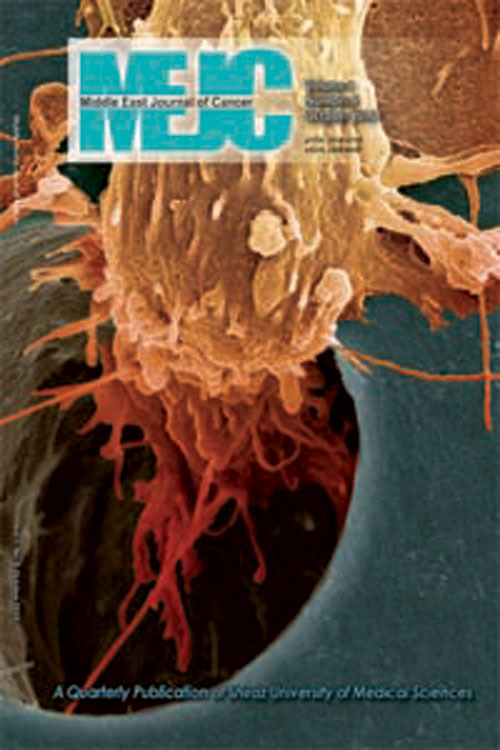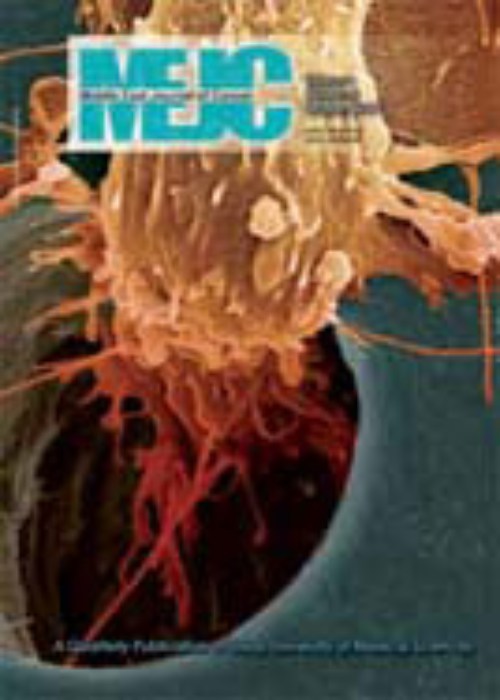فهرست مطالب

Middle East Journal of Cancer
Volume:8 Issue: 3, Jul 2017
- تاریخ انتشار: 1396/04/22
- تعداد عناوین: 8
-
-
Pages 119-126BackgroundGlioblastoma multiforme, the most common, aggressive malignant brain tumor which affects patients of all ages, is principally resistant to treatment. Ciprofloxacin is an antibiotic that belongs to the fluoroquinolones. There are welldocumented observations which indicate that ciprofloxacin has substantial anti-proliferative, apoptotic, cytotoxic and oxidative stress activities on various tumor cell lines.MethodsWe exposed the glioblastoma A-172 cell line to ciprofloxacin for 24, 48 and 72 h. Cytotoxicity was measured using MTT assay. The levels of Bax as an apoptotic and Bcl-2 as an anti-apoptotic protein were measured by ELISA and oxidative stress by the malondialdehyde assay.ResultsCiprofloxacin induced tumor cell death in a dose-dependent manner with an IC50 value of 259.3 μM at 72 h. We observed an increase in Bax levels, a decrease in Bcl-2 concentrations and increased Bax/Bcl-2 ratio under the influence of ciprofloxacin. Malondialdehyde levels, as an important marker of oxidative stress, increased in the human glioblastoma A-172 cell line.ConclusionThese results indicated that ciprofloxacin had anti-tumor, cytotoxic and apoptotic effects in the human glioblastoma A-172 cell line which might be useful as an adjuvant added to a glioblastoma multiforme chemotherapeutic protocol in the future.Keywords: Ciprofloxacin, Glioblastoma A-172 cell line, Cytotoxicity, Apoptosis, O xidative stress
-
Pages 127-134BackgroundNeoadjuvant chemotherapy can downstage the size of the tumor, thus allowing some patients with advanced disease with the option of conservative breast surgery. Our study aims to investigate the effectiveness of neoadjuvant chemotherapy in patients with locally advanced breast cancer.MethodsFifty-six patients had locally advanced breast cancer. Ten patients (18%) were stage IIB, 32 (57%) were stage IIIA, 9 (16%) were stage IIIB, and 5 (9%) were stage IIIC. Patients received neoadjuvant chemotherapy comprised of cyclophosphamide, doxorubicin, and fluorouracil followed by surgery (15 patients with breast conservative surgery,11 with skin sparing mastectomy and latesmus dorsi reconstruction, and 30 patients who underwent modified radical mastectomy) and then followed by radiotherapy, 50 Gy with conventional fractionation.ResultsClinical down staging was obtained in 49 (87.5%) patients: 5 (9%) had complete clinical response, 44 (78.5%) had partial response, 6 (10.7%) had stable disease, and 1 (1.8%) had progressive disease. The primary tumor could not be palpated after chemotherapy in 7 (12.5%) of 56 patients who presented with a palpable mass. Median follow-up was 47.5 months. The factors that correlated positively with locoregional recurrence on univariate analysis included hormonal receptor status and surgical margin status. On multivariate analysis, surgical margin status was the only independent significant factor for locoregional recurrence-free survival. In univariate analysis for distant relapse free survival, factors that correlated positively included disease stage and hormonal receptor status. Multivariate analysis showed that tumor stage and hormonal receptor status were independent significant factors that correlated with distant relapse-free survival.ConclusionNeoadjuvant chemotherapy was effective in clinical down staging and should be considered for patients with advanced breast cancer. It improved operability and enhanced local control and increased the possibility of breast-conserving surgery without affecting overall survival. Negative surgical margin was the independent significant factor in terms of locoregional recurrence while tumor stage and hormonal receptor status were the independent significant factors in term of distant relapse free survival.Keywords: Neoadjuvant, Chemotherapy, Breast cancer, Recurrence, Survival, Experience
-
Pages 135-141BackgroundRadiation induced esophageal toxicity is a primary cause of treatment interruptions in the radiotherapy of lung cancer, for which there are no clear predictive factors. This study attempts to identify risk factors associated with the development of severe radiation induced esophageal toxicity using clinical and dosimetric parameters.MethodsWe reviewed the medical records of 54 patients with histologically proven stage III non-small cell lung cancer treated with 3D-conformal radiotherapy at Alexandria Main University Hospital between January 2008 and December 2011. The original treatment plans for those patients were restored and imported to the treatment planning system. The external surface of esophagus was contoured for each patient. We calculated the esophagus dosevolume histograms and various dosimetric parameters. Univariate and multivariate logistic regression analyses were performed.ResultsOf the 54 patients, 6 (11.1%) had grade 3 radiation induced esophageal toxicity and 2 (3.7%) had grade 4. There was no grade 5 toxicity. The most statistically significant parameters for predicting RIET grade 3 or worse included esophageal volume that received ≥50 Gy (V50), esophageal volume that received ≥55 Gy (V55), and the use of concurrent chemotherapy according to univariate and multivariate logistic regression analyses.ConclusionThis study demonstrates that the best predictive factors for severe early radiation induced esophageal toxicity are concurrent chemotherapy, and esophageal volumes ≥50 Gy and ≥55 Gy in non-small cell lung cancer treated with 3D-conformal radiotherapy.Keywords: Dose–volume histogram, Lung cancer, Radiotherapy, Esophageal toxicity
-
Pages 143-150BackgroundWilms tumor is the most common malignant renal tumor in the pediatric age group. This tumor is classically managed by multimodal treatment which involves surgery, radiotherapy and chemotherapy. While there is plenty of data in world literature on the outcome of Wilms tumor, there is a paucity of data from India.MethodsAll patients with proven diagnosis of Wilms tumor between 2008 to 2012 were noted from the hospitals cancer registry. We performed detailed analyses of all patients clinical case records for demographic profiles, clinical features, imaging studies, treatment, and outcome. Histopathological classification of the tumor determined the patients post-operative management. All patients were followed for a period of 3 years and we analyzed the eventual outcome in the form of disease-free survival, complications, tumor recurrence, and mortality.ResultsThere were 31 cases of Wilms tumor included in this study. The median age of presentation was 3-4 years (range: 5 months-6 years) with a female: male ratio of 1.2:1. Abdominal mass was the chief presenting feature in 20 (64.5%) patients followed by abdominal pain in 6 (19.3%). All children had unilateral disease, 25 (80.6%) had right-sided and 6 (19.3%) had left-sided disease. Bilateral disease was seen in only one case. Of the 31 cases of Wilms tumor, 36% cases presented with stages I and II disease, 55% had stage III, and 9% of the cases were stage IV. Most cases of Wilms tumor were stage III. The majority had classical Wilms tumor with a favourable histology. The estimated 5-year event free survival was 87.3%ConclusionA multidisciplinary approach can approach similar survival rates compared to the National Wilms Tumor Study Group, even in the Indian scenario. Further improvement in survival of these children can only be achieved by increasing awareness, early recognition, appropriate referral, and a multidisciplinary approach.Keywords: Chemotherapy, Pediatric, Survival, Wilm's tumor
-
Pages 151-154BackgroundThis study evaluated sexual function in cervical cancer survivors after concurrent chemoradiotherapy.MethodsStudy participants comprised survivors of locally advanced cervical cancer (stages IIB-IVA) who completed concurrent chemoradiotherapy along with intracavitary brachytherapy at least two years prior at Dr S.N.Medical College, Jodhpur, Rajasthan, India. We used the Female Sexual Function Index questionnaire to assess sexual function. The cut-off score of the Female Sexual Function Index that identified female sexual arousal disorder was 26.55. A score less than 26.55 indicated the presence of female sexual arousal disorder.ResultsA total of 48 locally advanced cervical cancer survivors enrolled in the study. Survivors had a mean age of 46.5 years. All received chemoradiotherapy along with intracavitary brachytherapy. The average time for treatment was 53.5 days. Patients had an average score for sexual desire of 2, 2.3 for arousal, 2.3 for sexual satisfaction, and 2.1 for pain during intercourse. The overall average score was 11.84 (range: 3.2-19.5) with a cut-off of 26.55. All survivors suffered from female sexual arousal disorder.ConclusionCervical cancer survivors had decreased sexual function which indicated female sexual arousal disorder. Patient education and active treatment of complications related to cancer treatments is a must for improvement of sexual function among survivors. Long-term complications should be considered in terms of treatment planning and follow-up treatment to improve the quality of life of cancer survivors.Keywords: Cervical cancer, Sexual arousal disorder, Radiotherapy
-
Pages 155-160BackgroundOvarian cancer is the second most common type of female genital tract malignancy. Treatment planning differs for benign, borderline, and malignant subtypes of surface epithelial tumors and depends on accurate histopathological diagnosis. The aim of this study is to determine the accuracy and causes for error in intraoperative diagnosis of ovarian surface epithelial tumors.MethodsIn this retrospective study, we analyzed all cases of ovarian surface epithelial tumors referred to the Pathology Department of our hospital from April 2010 to December 2015. We considered the final diagnosis as the gold standard and determined the accuracy, sensitivity, specificity, positive predictive value, negative predictive value, underdiagnosis and overdiagnosis for each group of benign, borderline, and malignant tumors. An expert pathologist blinded to the diagnosis reviewed patients frozen and permanent slides and categorized causes of error into misinterpretation, sampling, and technical errors.ResultsWe assessed 220 patients slides (96 benign, 66 borderline, and 58 malignant tumors). The accuracy of the frozen section was: 98% in benign, 80.3% in borderline and 67.2% in malignant tumors. The frozen sections had a sensitivity of 97.9% for benign tumors and a sensitivity of 67.2% and specificity of 100% for malignant tumors. Borderline tumors had a sensitivity of 91% and specificity of 88.4%. Mucinous borderline tumors comprised the more frequent uncertain and underdiagnosed cases. The main cause for error in this group was sampling error. In malignant neoplasms, 15.5% were reported to be at least borderline. Technical issues were the cause of difficulty in interpretation. In the benign category, cystadenofibroma could be misinterpreted as a borderline malignancy.ConclusionFrozen section is an accurate, specific method for diagnosis of benign and malignant tumors. In the borderline category, the results should be interpreted with caution.Keywords: Intraoperative consultation, Diagnosis, Frozen section, Ovarian epithelial tumor, Accuracy, Error, Cause
-
Pages 161-165Small cell carcinoma of the ovary is an aggressive malignant tumor with no standard treatment. Despite surgery, chemotherapy and radiation, this tumor has a poor prognosis with rapid progression. The authors report a case of small cell carcinoma of the ovary in a 37-year-old woman who presented twice with an acute abdomen and unstable hemodynamics which led to two urgent laparatomies. The patient died two months after her diagnosis of small cell carcinoma of the ovary and one course of chemotherapy.Keywords: Ovary, Small cell carcinoma
-
Pages 167-169


